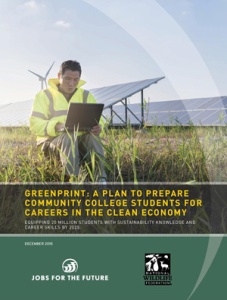Editor’s note: This message is adapted from the Illinois Green Economy Network’s News and Events webpage announcement.
Jobs for the Future, National Wildlife Federation, Bank of America, and education leaders all across North America last month released Greenprint: A Plan to Prepare Community College Students for Careers in the Clean Economy. This plan comes at a critical time, in the wake of the historic Paris accord, in which 195 nations agreed to invest in lowering global greenhouse gas emissions. These leaders will challenge all nations to develop a workforce skilled in sustainability.
The objective of the Greenprint plan is to equip 20 million students with sustainability knowledge and career skills by 2025. This new report begins to address the challenge of linking environmental quality and workforce development.
Highlights of the Greenprint plan include:
- A call to key stakeholder groups such as government and the private sector to work with education institutions to increase programs and employment opportunities for a workforce with sustainability skills.
- A review of federal and state policy vehicles that can provide clearer and more direct support of sustainability skills and knowledge.
- The marrying of sustainability education programs with STEM (science, technology, engineering, and math) education.
- How student organizations can play a role in supporting the nation’s transition to a greener workforce.
The Greenprint plan was created by thought leaders representing industry associations, student groups, nonprofit organizations, government agencies, and higher education entities in the U.S. and Canada who participated in a national and statewide convening as part of the Greenforce Initiative, organized by the National Wildlife Federation and Jobs for the Future with support from Bank of America Charitable Foundation, NASA, Charles Stewart Mott Foundation, The Kendeda Fund, and other donors.

